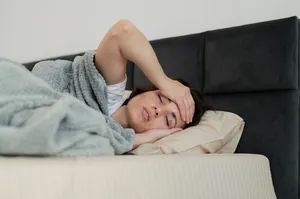Sleep Paralysis: When the Body Sleeps but Consciousness is Awake
Theresa Hauser, MSc. | 04.11.2025

One lies in bed, wants to move – but nothing works. The muscles are like paralyzed, sometimes accompanied by pressure on the chest or threatening hallucinations. This phenomenon is called sleep paralysis.
For those affected, it is extremely frightening, for science a fascinating example of how sensitive the interaction between the brain, body, and sleep architecture is.
In this article, we explain what happens during sleep paralysis, why it occurs – and how to manage it.
What is sleep paralysis?
Sleep paralysis is a temporary inability to move when falling asleep (hypnagogic) or waking up (hypnopompic).
The body is already in REM sleep, during which the muscles are normally blocked by a protective reaction to prevent movements during dreaming.
However, consciousness partially awakens – the result:
Awake in the mind, but paralyzed in the body.
This phase usually lasts between a few seconds and two minutes. Medically it is harmless, but emotionally it is often extremely distressing.
Typical symptoms
- Inability to move despite full consciousness
- Feeling of pressure or tightness on the chest and airways
- Auditory or visual hallucinations (“shadow figures”, voices, threats)
- Intense fear reaction and increased pulse
- Difficulty distinguishing between dream and reality
Such perceptions arise because dream content spills over into the waking state as the brain tries to gain orientation.
Test sleep² now and learn to sleep better!
To the sleep² appWhy does sleep paralysis occur?
The exact cause is not fully understood, but several factors increase the risk:
- Irregular sleep rhythm
Shift work, jet lag, or lack of sleep destabilize sleep phase transitions.
- REM intrusion
Parts of REM sleep intrude into the waking state. Particularly common in people with high stress or sleep deficit.
- Stress & anxiety disorders
Chronic tension promotes fragmented sleep and frequent REM transitions.
- Supine position
Studies show that paralysis episodes occur significantly more often in the supine position.
- Familial predisposition
Twin studies suggest a moderate genetic component.
How common is the phenomenon?
About 8% of the general population experience sleep paralysis at least once in their life.
Among students, shift workers, or people with irregular sleep, the frequency is up to 30%.
Repeated episodes are more common in individuals with insomnia or post-traumatic stress.
What happens in the brain?
During the REM sleep phase, the brainstem sends signals that inhibit the motor neurons – a so-called atonic protective function.
Normally, this inhibition is released once we wake up.
However, if consciousness returns before, we experience the discrepancy between an awake mind and a paralyzed body.
In parallel, the amygdala and limbic system are activated, explaining the intense fear reaction.
What helps against sleep paralysis?
1. Regular sleep rhythm
The most important protective factor. Consistent bed and wake times stabilize REM transitions.
2. Sleep hygiene & sleep quality
- No caffeine or alcohol in the evening
- Dark, cool bedroom (18–20 °C)
- Relaxation rituals: breathing exercises, meditation, “notebook method”
3. Position change
Those who frequently sleep on their back can try using special textiles that are elevated at the back (“backpack shirts”) or simply take a tennis ball, attach a rope, and strap it to their back…
4. Stress management
Mental stress enhances REM intrusions. Relaxation techniques, mindfulness, and behavioral therapy help reduce stress levels.
5. Behavior in acute cases
When an episode occurs:
- Focus on small movements (fingers, toes).
- Focus on calm breathing.
- Remember: The paralysis is harmless and subsides in seconds.
This awareness reduces fear and measurably shortens the duration!
When medical clarification is advisable
In case of frequent episodes (several times a week) or additional severe daytime sleepiness, a sleep diagnosis in a sleep laboratory should be conducted to rule out narcolepsy or sleep apnea.
These conditions can trigger similar mechanisms but require targeted treatment.
Conclusion
Sleep paralysis is not a supernatural experience but a misregulation in the transition between REM sleep and wakefulness.
Although it can seem frightening, it is medically harmless – and with regular sleep, stress reduction, and good sleep hygiene, it is mostly avoidable.
Understanding what happens at this moment dispels fear – and regains control over one's nights.





